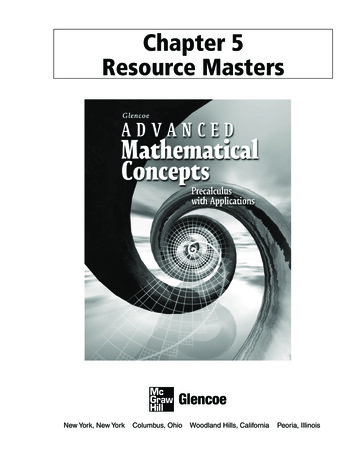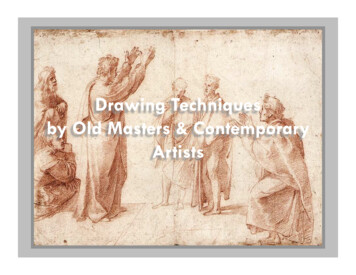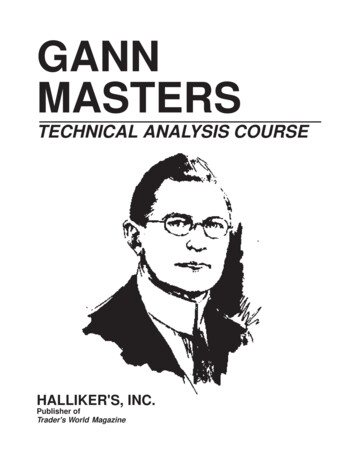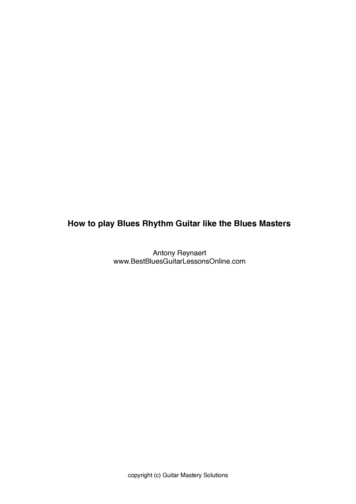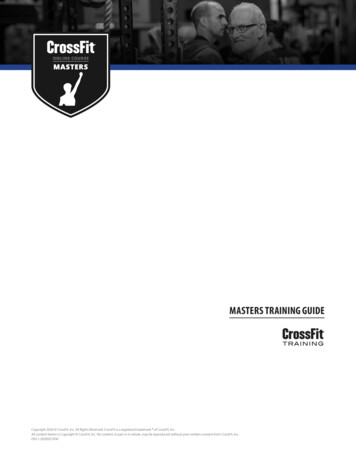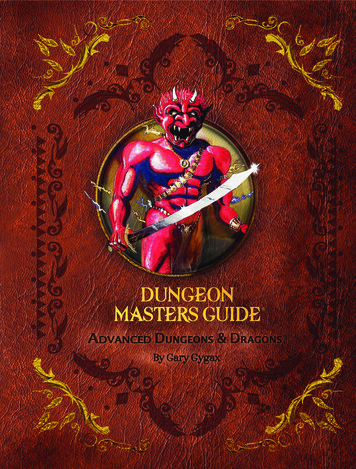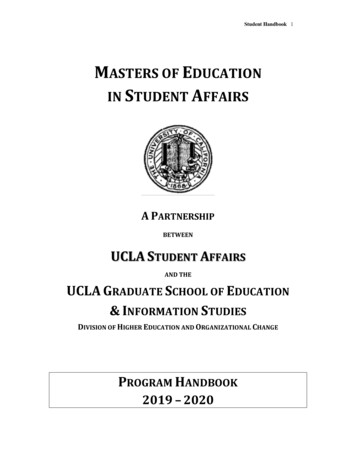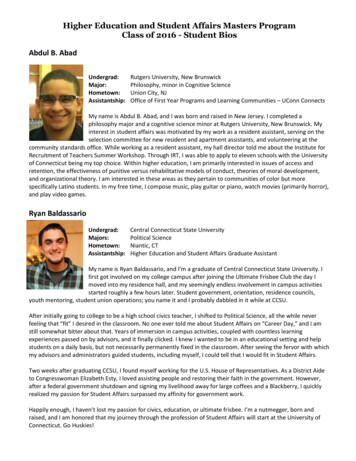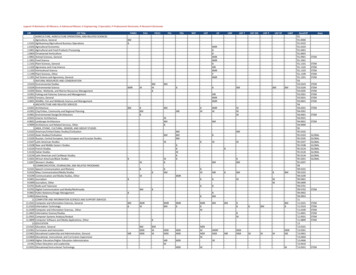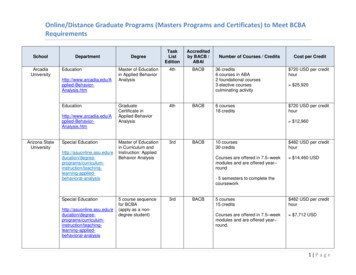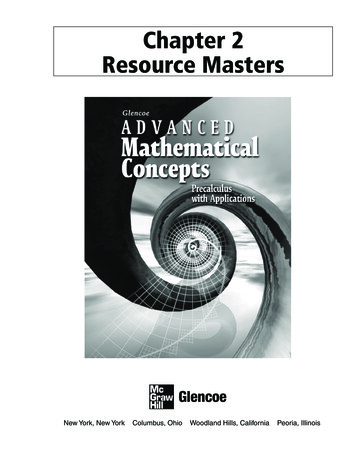
Transcription
Chapter 2Resource MastersNew York, New YorkColumbus, OhioWoodland Hills, CaliforniaPeoria, Illinois
StudentWorksTM This CD-ROM includes the entire Student Edition along with theStudy Guide, Practice, and Enrichment masters.TeacherWorksTM All of the materials found in this booklet are included for viewingand printing in the Advanced Mathematical Concepts TeacherWorksCD-ROM.Copyright The McGraw-Hill Companies, Inc. All rights reserved.Printed in the United States of America. Permission is granted to reproduce thematerial contained herein on the condition that such material be reproduced onlyfor classroom use; be provided to students, teachers, and families without charge;and be used solely in conjunction with Glencoe Advanced Mathematical Concepts.Any other reproduction, for use or sale, is prohibited without prior writtenpermission of the publisher.Send all inquiries to:Glencoe/McGraw-Hill8787 Orion PlaceColumbus, OH 43240-4027ISBN: 0-07-869129-X1 2 3 4 5 6 7 8 9 10Advanced Mathematical ConceptsChapter 2 Resource MastersXXX11 10 09 08 07 06 05 04
ContentsVocabulary Builder . . . . . . . . . . . . . . . . . vii-xLesson 2-7Study Guide . . . . . . . . . . . . . . . . . . . . . . . . . . 63Practice . . . . . . . . . . . . . . . . . . . . . . . . . . . . . . 64Enrichment . . . . . . . . . . . . . . . . . . . . . . . . . . . 65Lesson 2-1Study Guide . . . . . . . . . . . . . . . . . . . . . . . . . . 45Practice . . . . . . . . . . . . . . . . . . . . . . . . . . . . . . 46Enrichment . . . . . . . . . . . . . . . . . . . . . . . . . . . 47Chapter 2 AssessmentChapter 2 Test, Form 1A . . . . . . . . . . . . . . 67-68Chapter 2 Test, Form 1B . . . . . . . . . . . . . . 69-70Chapter 2 Test, Form 1C . . . . . . . . . . . . . . 71-72Chapter 2 Test, Form 2A . . . . . . . . . . . . . . 73-74Chapter 2 Test, Form 2B . . . . . . . . . . . . . . 75-76Chapter 2 Test, Form 2C . . . . . . . . . . . . . . 77-78Chapter 2 Extended ResponseAssessment . . . . . . . . . . . . . . . . . . . . . . . . 79Chapter 2 Mid-Chapter Test . . . . . . . . . . . . . . 80Chapter 2 Quizzes A & B . . . . . . . . . . . . . . . . 81Chapter 2 Quizzes C & D. . . . . . . . . . . . . . . . 82Chapter 2 SAT and ACT Practice . . . . . . . 83-84Chapter 2 Cumulative Review . . . . . . . . . . . . 85Lesson 2-2Study Guide . . . . . . . . . . . . . . . . . . . . . . . . . . 48Practice . . . . . . . . . . . . . . . . . . . . . . . . . . . . . . 49Enrichment . . . . . . . . . . . . . . . . . . . . . . . . . . . 50Lesson 2-3Study Guide . . . . . . . . . . . . . . . . . . . . . . . . . . 51Practice . . . . . . . . . . . . . . . . . . . . . . . . . . . . . . 52Enrichment . . . . . . . . . . . . . . . . . . . . . . . . . . . 53Lesson 2-4Study Guide . . . . . . . . . . . . . . . . . . . . . . . . . . 54Practice . . . . . . . . . . . . . . . . . . . . . . . . . . . . . . 55Enrichment . . . . . . . . . . . . . . . . . . . . . . . . . . . 56SAT and ACT Practice Answer Sheet,10 Questions . . . . . . . . . . . . . . . . . . . . . . . A1SAT and ACT Practice Answer Sheet,20 Questions . . . . . . . . . . . . . . . . . . . . . . . A2ANSWERS . . . . . . . . . . . . . . . . . . . . . . A3-A16Lesson 2-5Study Guide . . . . . . . . . . . . . . . . . . . . . . . . . . 57Practice . . . . . . . . . . . . . . . . . . . . . . . . . . . . . . 58Enrichment . . . . . . . . . . . . . . . . . . . . . . . . . . . 59Lesson 2-6Study Guide . . . . . . . . . . . . . . . . . . . . . . . . . . 60Practice . . . . . . . . . . . . . . . . . . . . . . . . . . . . . . 61Enrichment . . . . . . . . . . . . . . . . . . . . . . . . . . . 62 Glencoe/McGraw-HilliiiAdvanced Mathematical Concepts
A Teacher’s Guide to Using theChapter 2 Resource MastersThe Fast File Chapter Resource system allows you to conveniently file theresources you use most often. The Chapter 2 Resource Masters include the corematerials needed for Chapter 2. These materials include worksheets, extensions,and assessment options. The answers for these pages appear at the back of thisbooklet.All of the materials found in this booklet are included for viewing and printing inthe Advanced Mathematical Concepts TeacherWorks CD-ROM.Vocabulary Builder Pages vii-x include aPractice There is one master for each lesson.student study tool that presents the keyvocabulary terms from the chapter. Students areto record definitions and/or examples for eachterm. You may suggest that students highlight orstar the terms with which they are not familiar.These problems more closely follow thestructure of the Practice section of the StudentEdition exercises. These exercises are ofaverage difficulty.When to Use These provide additionalpractice options or may be used as homeworkfor second day teaching of the lesson.When to Use Give these pages to studentsbefore beginning Lesson 2-1. Remind them toadd definitions and examples as they completeeach lesson.Enrichment There is one master for eachlesson. These activities may extend the conceptsin the lesson, offer a historical or multiculturallook at the concepts, or widen students’perspectives on the mathematics they arelearning. These are not written exclusivelyfor honors students, but are accessible for usewith all levels of students.Study Guide There is one Study Guidemaster for each lesson.When to Use Use these masters asreteaching activities for students who needadditional reinforcement. These pages can alsobe used in conjunction with the Student Editionas an instructional tool for those students whohave been absent. Glencoe/McGraw-HillWhen to Use These may be used as extracredit, short-term projects, or as activities fordays when class periods are shortened.ivAdvanced Mathematical Concepts
Assessment OptionsIntermediate AssessmentThe assessment section of the Chapter 2Resources Masters offers a wide range ofassessment tools for intermediate and finalassessment. The following lists describe eachassessment master and its intended use.Chapter Tests Forms 1A, 1B, and 1C Form 1 tests containmultiple-choice questions. Form 1A isintended for use with honors-level students,Form 1B is intended for use with averagelevel students, and Form 1C is intended foruse with basic-level students. These testsare similar in format to offer comparabletesting situations.Forms 2A, 2B, and 2C Form 2 tests arecomposed of free-response questions. Form2A is intended for use with honors-levelstudents, Form 2B is intended for use withaverage-level students, and Form 2C isintended for use with basic-level students.These tests are similar in format to offercomparable testing situations.The Extended Response Assessmentincludes performance assessment tasks thatare suitable for all students. A scoringrubric is included for evaluation guidelines.Sample answers are provided forassessment. Glencoe/McGraw-Hill Four free-response quizzes are included tooffer assessment at appropriate intervals inthe chapter. The SAT and ACT Practice offerscontinuing review of concepts in variousformats, which may appear on standardizedtests that they may encounter. This practiceincludes multiple-choice, quantitativecomparison, and grid-in questions. Bubblein and grid-in answer sections are providedon the master. The Cumulative Review provides studentsan opportunity to reinforce and retain skillsas they proceed through their study ofadvanced mathematics. It can also be usedas a test. The master includes free-responsequestions.AnswersAll of the above tests include a challengingBonus question. A Mid-Chapter Test provides an option toassess the first half of the chapter. It iscomposed of free-response questions.Continuing AssessmentChapter Assessments v Page A1 is an answer sheet for the SAT andACT Practice questions that appear in theStudent Edition on page 65. Page A2 is ananswer sheet for the SAT and ACT Practicemaster. These improve students’ familiaritywith the answer formats they mayencounter in test taking. The answers for the lesson-by-lessonmasters are provided as reduced pages withanswers appearing in red. Full-size answer keys are provided for theassessment options in this booklet.Advanced Mathematical Concepts
Chapter 2 Leveled WorksheetsGlencoe’s leveled worksheets are helpful for meeting the needs of everystudent in a variety of ways. These worksheets, many of which are foundin the FAST FILE Chapter Resource Masters, are shown in the chartbelow. Study Guide masters provide worked-out examples as well as practiceproblems. Each chapter’s Vocabulary Builder master provides students theopportunity to write out key concepts and definitions in their ownwords. Practice masters provide average-level problems for students whoare moving at a regular pace. Enrichment masters offer students the opportunity to extend theirlearning.Five Different Options to Meet the Needs ofEvery Student in a Variety of Waysprimarily skillsprimarily conceptsprimarily applicationsBASICAVERAGE1Study Guide2Vocabulary Builder3Parent and Student Study Guide (online) dvanced Mathematical Concepts
NAME DATE PERIODChapter2Reading to Learn MathematicsVocabulary BuilderThis is an alphabetical list of the key vocabulary terms you will learn in Chapter 2.As you study the chapter, complete each term’s definition or description.Remember to add the page number where you found the term.Vocabulary TermFoundon PageDefinition/Description/Exampleadditive identity matrixalternate optimal solutioncolumn ationdimensionselement(continued on the next page) Glencoe/McGraw-HillviiAdvanced Mathematical Concepts
NAME DATE PERIODChapter2Reading to Learn MathematicsVocabulary Builder (continued)Vocabulary TermFoundon PageDefinition/Description/Exampleelimination methodequal matricesidentity matrix for leinverse matrixlinear programmingm n matrixmatrix(continued on the next page) Glencoe/McGraw-HillviiiAdvanced Mathematical Concepts
NAME DATE PERIODChapter2Reading to Learn MathematicsVocabulary Builder (continued)Vocabulary TermFoundon PageDefinition/Description/Exampleminornth orderordered triplepolygonal convex setpre-imagereflectionreflection matrixrotationrotation matrixrow matrixscalar(continued on the next page) Glencoe/McGraw-HillixAdvanced Mathematical Concepts
NAME DATE PERIODChapter2Reading to Learn MathematicsVocabulary Builder (continued)Vocabulary TermFoundon PageDefinition/Description/Examplesolutionsquare matrixsubstitution methodsystem of equationssystem of linear inequalitiestransformationstranslationtranslation matrixunboundedvertex matrixVertex Theoremzero matrix Glencoe/McGraw-HillxAdvanced Mathematical Concepts
NAME DATE PERIOD2-1Study GuideSolving Systems of Equations in Two VariablesOne way to solve a system of equations in two variables is bygraphing. The intersection of the graphs is called the solutionto the system of equations.Example 1Solve the system of equations by graphing.3x y 10x 4y 12First rewrite each equation of the system inslope-intercept form by solving for y.3x y 10x 4y 12becomesy 3x 10y 14 x 3The solution to the system is (4, 2).A consistent system has at least one solution.A system having exactly one solution is independent.If a system has infinitely many solutions, the system is dependent.Systems that have no solution are inconsistent.Systems of linear equations can also be solved algebraicallyusing the elimination method or the substitution method.Example 3Use the substitution method tosolve the system of equations.x 7y 32x y 7The first equation is stated in terms of x,so substitute 7y 3 for x in the secondequation.2x y 72(7y 3) y 713y 13y 1Now solve for x by substituting 1 for yin either of the original equations.x 7y 3x 7( 1) 3y 1x 4The solution is ( 4, 1).Example 2Use the elimination method to solvethe system of equations.2x 3y 215x 6y 15To solve this system, multiply each sideof the first equation by 2, and add thetwo equations to eliminate y. Then solvethe resulting equation.2(2x 3y) 2( 21) 4x 6y 424x 6y 425x 6y 159x 27x 3Now substitute 3 for x in either of theoriginal equations.5x 6y 155( 3) 6y 15x 36y 30y 5The solution is ( 3, 5). Glencoe/McGraw-Hill45Advanced Mathematical Concepts
NAME DATE PERIOD2-1PracticeSolving Systems of Equations in Two VariablesState whether each system is consistent and independent,consistent and dependent, or inconsistent.1. x y 43x 3y 122. 2x 5y 815y 6x 24Solve each system of equations by graphing.3. x y 62x 3y 124. x y 63x y 6Solve each system of equations algebraically.5. x y 43x 2y 76. 3x 4y 10 3x 4y 88. 4x 5y 113x 2y 99. 2x 3y 197x y 97. 4x 3y 152x y 510. 2x y 6x y 611. Real Estate AMC Homes, Inc. is planning to build three- and four-bedroomhomes in a housing development called Chestnut Hills. Consumer demandindicates a need for three times as many four-bedroom homes as for three-bedroomhomes. The net profit from each three-bedroom home is 16,000 and from eachfour-bedroom home, 17,000. If AMC Homes must net a total profit of 13.4 millionfrom this development, how many homes of each type should they build? Glencoe/McGraw-Hill46Advanced Mathematical Concepts
NAME DATE PERIOD2-1EnrichmentSet Theory and Venn DiagramsSet theory, which was developed by the nineteenth century Germanlogician and mathematician, Georg Cantor, became a fundamentalunifying principle in the study of mathematics in the middle of thetwentieth century. The use of sets permits the precise description ofmathematical concepts.The intersection of two sets determines the elements common to thetwo sets. Thus, the intersection of two lines in a system of equationsrefers to the point or points that are common to the sets of pointsbelonging to each of the lines. We can use Venn diagrams, which arenamed for the British logician, John Venn, to visually represent theintersection of two sets.ExampleLet U the set of all points in the Cartesian coordinate plane.Let A the set of all points that satisfy the equation x 4.Let B the set of all points that satisfy the equation y 2.Draw a Venn diagram to represent U, A, and B.The shaded region represents theintersection of sets A and B, written A B. In this example,A B {(4, –2)}.Since the solution sets of two parallel lines have no points in common, the sets are called disjoint sets. In a Venn diagram, such setsare drawn as circles that do not overlap.A B .Use the diagram at the right to answer the following questions.Let A the set of all points that satisfy the equation for line p.Let B the set of all points that satisfy the equation for line q.1. In which numbered region do the points that satisfy only theequation for line p lie?2. In which numbered region do the points that satisfy only theequation for line q lie?3. In which numbered region do the points that satisfy the equationsfor neither line p nor line q lie?4. If the equation of line p is 2x y 4 and the equation of line q is3x y 6, which point lies in region 2? Glencoe/McGraw-Hill47Advanced Mathematical Concepts
NAME DATE PERIOD2-2Study GuideSolving Systems of Equations in Three VariablesYou can solve systems of three equations in three variablesusing the same algebraic techniques you used to solvesystems of two equations.ExampleSolve the system of equations by elimination.4x y 2z 82x 3y 4z 4 7x 2y 3z 2Choose a pair of equations and then eliminate one of thevariables. Because the coefficient of y is 1 in the firstequation, eliminate y from the second and third equations.To eliminate y using the first andsecond equations, multiply both sides ofthe first equation by 3.To eliminate y using the first and thirdequations, multiply both sides of the firstequation by 2.3(4x y 2z) 3( 8)12x 3y 6z 24 2(4x y 2z) 2( 8) 8x 2y 4z 16Then add the second equation to thatresult.Then add the third equation to thatresult.12x 3y 6z 242x 3y 4z 414x 2z 20 8x 2y 4z 16 7x 2y 3z 2 15x z 18Now you have two linear equations in two variables. Solvethis system. Eliminate z by multiplying both sides of thesecond equation by 2. Then add the two equations.2( 15x z) 2(18) 30x 2z 3614x 2z 20 30x 2z 36 16x 16x 1By substituting the value of x into oneof the equations in two variables, we cansolve for the value of z.14x 2z 2014( 1) 2z 20z 3The value of x is 1.Finally, use one of the original equationsto find the value of y.4x y 2z 84( 1) y 2( 3) 8y 2x 1x 1, z 3The value of y is 2.The value of z is 3.The solution is x 1, y 2, z 3. This can be written asthe ordered triple ( 1, 2, 3). Glencoe/McGraw-Hill48Advanced Mathematical Concepts
NAME DATE PERIOD2-2PracticeSolving Systems of Equations in Three VariablesSolve each system of equations.1. x y z 1x y z 33x 2y z 42. x y 53x z 24y z 83. 3x 5y z 84y z 107x y 44. 2x 3y 3z 210x 6y 3z 04x 3y 6z 25. 2x y z 1x y z 1x 2y z 26. 4x 4y 2z 3 6x 6y 6z 52x 3y 4z 27. x z 5y 3z 122x y 78. 2x 4y 2z 94x 6y 2z 9x y 3z 49. Business The president of Speedy Airlines has discovered that hercompetitor, Zip Airlines, has purchased 13 new airplaines from CommuterAviation for a total of 15.9 million. She knows that Commuter Aviationproduces three types of planes and that type A sells for 1.1 million, type Bsells for 1.2 million, and type C sells for 1.7 million. The president ofSpeedy Airlines also managed to find out that Zip Airlines purchased 5more type A planes than type C planes. How many planes of each typedid Zip Airlines purchase? Glencoe/McGraw-Hill49Advanced Mathematical Concepts
NAME DATE PERIOD2-2EnrichmentGraph ColoringThe student council is scheduling a volleyball tournament for teamsfrom all four classes. They want each class team to play every otherclass team exactly once. How should they schedule the tournament?If we call the teams A, B, C, and D, all of the possible games among thefour teams can be represented as AB, AC, AD, BC, BD, and CD.Draw a graph to represent the problem. Then color the graph.To color a graph means to color the vertices of that graph so that notwo vertices connected by an edge have the same color.Let the vertices represent the possible games. Let the edges representgames that cannot be scheduled at the same time. For example, if teamB is playing team C, then team C cannot playteam D.Choose a vertex at which to begin. Color AB red. Since CD is not connected to AB,color it red as well. All of the other vertices areconnected to AB, so do not color them red. Color AC blue. Since BD is not connected toAC, color it blue. Color AD green. Since BC is not connected toAD, color it green.The colored graph shows that pairs of games can bescheduled as followsAB with CD; AC with BD; AD with BCThe chromatic number of a graph is the least number of colorsnecessary to color the graph. The chromatic number of the graphabove is 3.1. What does the chromatic number of the graph in the example aboverepresent?2. Draw and color a graph to represent the same type of tournament,but with 6 teams playing.3. What is the chromatic number for your graph? Glencoe/McGraw-Hill50Advanced Mathematical Concepts
NAME DATE PERIOD2-3Study GuideModeling Real-World Data with MatricesA matrix is a rectangular array of terms called elements.A matrix with m rows and n columns is an m n matrix.The dimensions of the matrix are m and n.Example 1Find the values of x and y for which3x 5y 9 is true.y 4x冤冥 冤冥Since the corresponding elements mustbe equal, we can express the equalmatrices as two equations.3x 5 y 93x 5 ( 4x) 9 Substitute 4x for y.x 23x 5 y 9y 4xy 4xy 4( 2) Substitute 2 for x.y 8Solve the system of equations by usingsubstitution.The matrices are equal if x 2 and y 8.To add or subtract matrices, the dimensions of the matricesmust be the same.Example 2冤3Find C D if C 2冥C D C ( D) 1 53 6 2 4 7 8 3 ( 1) 2 7冤16andD 74冥58 . 6 ( 5)4 ( 8) 2 1 5 4To multiply two matrices, the number of columns in the first matrixmust be equal to the number of rows in the second matrix. Theproduct of two matrices is found by multiplying columns and rows.4 38 0and Y .Example 3 Find each product if X 5 29 6a. XY4(8) 3(9) 4(0) 3( 6)59 18XY or5(8) 2(9) 5(0) 2( 6)58 12冤 b. YXYX Glencoe/McGraw-Hill 0(5) 9(4)8(4) ( 6)(5)冥冤 8(3) 0(2)32or9(3) ( 6)(2)6 51冥 2415 Advanced Mathematical Concepts
NAME DATE PERIOD2-3PracticeModeling Real-World Data with MatricesFind the values of x and y for which each matrix equation istrue.x2y 42x 3y 2. 1.y2x4y3x Use matrices A, B, and C to find each sum, difference, orproduct.2 3 1 1568 10 92 7 2A B 1 1 4C 612 14425 2 34 3. A B4. A B5. B A6. 2A7. CA8. AB9. AA10. CB11. (CA)B12. C(AB)13. Entertainment On one weekend, theGoxfield Theater reported the followingticket sales for three first-run movies, asshown in the matrix at the right. If theticket prices were 6 for each adult and 4 for each child, what were the weekendsales for each movie. Glencoe/McGraw-Hill52Movie 1Movie 2Movie 3Adults Children102152325477853652 2456 Advanced Mathematical Concepts
NAME DATE PERIOD2-3EnrichmentElementary Matrix TransformationsElementary row transformations can be made by multiplying a matrix onthe left by the appropriate transformation matrix. For example, tointerchange rows 2 and 3 in a 3 3 matrix, multiply the1 0 0matrix on the left by the matrix 0 0 1 .0 1 0Example 5 3 11 0 0150. Multiply on the left by 0 0 1 .Let C 10 6 20 1 0–5 3 1–5 3 11 5 0 10 – 6 –21 5 010 – 6 21 0 00 0 10 1 0 More complicated row transformations can also be made by a matrix multiplier.ExampleFind the elementary matrix that, when matrix A is multipliedby it on the left, row 1 will be replaced by the sum of 2 timesrow 1 and row 3.a11 a12 a13a11 a12 a13aaaa21 a22 a23 Let A 212223 .Find M such that Ma31 a32 a33a31 a32 a33 2a11 a31 2a12 a32 2a13 a332 0 1a21a22a23. Try M 0 1 0 .a31a32a330 0 1Check to see that the product MA meets the required conditions.1. Find the elementary matrix that willinterchange rows 1 and 3 of matrix A.2. Find the elementary matrix that willmultiply row 2 of matrix A by 5.3. Find the elementary matrix that willmultiply the elements of the first rowof matrix A by –2 and add the resultsto the corresponding elements of thethird row.4. Find the elementary matrix that willinterchange rows 2 and 3 of matrix Aand multiply row 1 by –2.5. Find the elementary matrix that will multiply the elements of the second row ofmatrix A by –3 and add the results to the corresponding elements of row 1. Glencoe/McGraw-Hill53Advanced Mathematical Concepts
NAME DATE PERIOD2-4Study GuideModeling Motion with MatricesYou can use matrices to perform many transformations, such astranslations (slides), reflections (flips), rotations (turns), anddilations (enlargements or reductions).Example 1 Suppose quadrilateral EFGH with verticesE( 1, 5), F(3, 4), G(4, 0), and H( 2, 1) istranslated 2 units left and 3 units down. 1 3The vertex matrix for the quadrilateral is5 4 The translation matrix is4 2.0 1 2 2 2. 2 3 3 3 3 Adding the two matrices gives the coordinates of thevertices of the translated quadrilateral. 1 3 4 2 2 2 2 2 3 1 2 4 5 4 0 1 3 3 3 32 1 3 2 Graphing the pre-image and the image of thetranslated quadrilateral on the same axes, wecan see the effect of the translation.The chart below summarizes the matrices needed to produce specificreflections or rotations. All rotations are counterclockwise about the origin.ReflectionsRx-axis 0RotationsRot90 1Example 210 10 10 Ry-axis Rot180 0 1 01 1 00 1 Ry x Rot270 01 1 010A triangle has vertices A( 1, 2), B(4, 4), and C(3, 2).Find the coordinates of the image of the triangle aftera rotation of 90 counterclockwise about the origin. 1 4 3.The vertex matrix isB 2 4 2Multiply it by the 90 rotation matrix. 1 10 · 120Example 3 1 0 4 3 2 4 4 2 1 4 23 yBC AxOA CTrapezoid WXYZ has vertices W(2, 1),X(1, 2), Y( 1, 2), and Z( 2, 1). Find thecoordinates of dilated trapezoid W′X′Y′Z′ fora scale factor of 2.5.Perform scalar multiplication on the vertexmatrix for the trapezoid.5 2.5 2.5 52 1 1 22.5 2.5 5 5 2.51 2 2 1 Glencoe/McGraw-Hill 54Advanced Mathematical Concepts
NAME DATE PERIOD2-4PracticeModeling Motion with MatricesUse scalar multiplication to determine the coordinates of thevertices of each dilated figure. Then graph the pre-image and theimage on the same coordinate grid.1. triangle with vertices2. quadrilateral withA(1, 2), B(2, 1), andvertices E( 2, 7),C( 2, 0); scale factor 2F(4, 3), G(0, 1),and H( 4, 2); scalefactor 0.5Use matrices to determine the coordinates of the vertices of eachtranslated figure. Then graph the pre-image and the image on thesame coordinate grid.3. square with vertices4. triangle with verticesW(1, 3), X( 4, 2),J(3, 1), K(2, 4), andY( 3, 3), and Z(2, 2)L(0, 2) translatedtranslated 2 units4 units left andright and 3 units2 units updownUse matrices to determine the coordinates of the vertices of eachreflected figure. Then graph the pre-image and the image on thesame coordinate grid.6. a rhombus with5. 䉭MNP with verticesvertices Q(2, 3),M( 3, 4), N(3, 1), andR(4, 1), S( 1, 2),P( 4, 3) reflectedandT( 3, 2)over the y-axisreflected over theline y xUse matrices to determine the coordinates of the vertices of eachrotated figure. Then graph the pre-image and the image on thesame coordinate grid.7. quadrilateral CDFG8. Pentagon VWXYZwith vertices C( 2, 3),with vertices V(1, 3),D(3, 4), F(3, 1), andW(4, 2), X(3, 2),G( 3, 4) rotated 90 Y( 1, 4), Z( 2, 1)rotated 180 Glencoe/McGraw-Hill55Advanced Mathematical Concepts
NAME DATE PERIOD2-4EnrichmentMap ColoringEach of the graphs below is drawn on a plane with no accidental crossings of its edges.This kind of graph is called a planar graph. A planar graph separates the plane intoregions. A very famous rule called the four-color theorem states that every planar graphcan be colored with at most four colors, without any adjacent regions having the samecolor.Graph AGraph BGraph CGraph Done regiontwo regionsthree regionsthree regionsone colortwo colorstwo colorsthree colorsIf there are four or more regions, two, three, or four colors may be required.ExampleColor the map at the right using theleast number of colors.Look for the greatest number of isolatedstates or regions. Virginia, Georgia, andMississippi are isolated. Color them pink.Alabama and North Carolina are alsoisolated. Color them blue.South Carolina and Tennessee areremaining. Because they do not share acommon edge, they may be colored with thesame color. Color them both green.Thus, three colors are needed to color thismap.Color each map with the least number of colors.1. Glencoe/McGraw-Hill2.56Advanced Mathematical Concepts
NAME DATE PERIOD2-5Study GuideDeterminants and Multiplicative Inverses of MatricesEach square matrix has a determinant. The determinant ofa1 b1a1 b1a 2 2 matrix is a number denoted byor det.a2 b2a2 b2Its value is a1b2 a2b1. Example 1Find the value of 5 2.3 1 5 2 5(1) 3( 2) or 113 1 The minor of an element can be found bydeleting the row and column containingthe element.The minor of a1 isExample 2 b2 c2.b3 c39528Find the value of3 1 37 ·4 35 73 73 9 37 82 4 1 4 14 8(6) 9(19) 3(11) or 9095283 1 a1 b1 c1a2 b2 c2a3 b3 c3 52The multiplicative inverse of a matrix is defined as follows.If A Example 3 aa bb and aa bb 0, then A11112222 1 ab22 b1.a1Solve the system of equations by using matrix equations.5x 4y 33x 5y 24Now multiply each side of the matrixWrite the system as a matrixequation by the inverse and solve.equation.5 4x 5 4 31 3 5 y7 355 4x 3· 3 5y 24 5 4 3 31 7 35 24To solve the matrix equation,first find the inverse of the 3x coefficient matrix.3y1The solution is ( 3, 3).5 4 5 4 1 5 437 35 353 5 Glencoe/McGraw-Hill 57Advanced Mathematical Concepts
NAME DATE PERIOD2-5PracticeDeterminants and Multiplicative Inverses of MatricesFind the value of each determinant. 231.8 12 0452. 1 13. 2 15 3 2 34. 3 11 4Find the inverse of each matrix, if it exists.3 85. 1 5 37 59 6. 152 105 24 Solve each system by using matrix equations.7. 2x 3y 173x y 98. 4x 3y 162x 5y 18Solve each matrix equation. 1 11 7 8x2 1 313 , if the inverse is 1 1 19.1 2 1 · y 6 17 5 7z 1 3 2 5 210. 3 41 3 122 10 2x41212 · y 0 , if the inverse is 18 5 14131z111. Landscaping Two dump truck have capacities of 10 tons and 12 tons.They make a total of 20 round trips to haul 226 tons of topsoil for alandscaping project. How
Feb 02, 2015 · the Advanced Mathematical Concepts TeacherWorks CD-ROM. Vocabulary Builder Pages vii-x include a student study tool that presents the key vocabulary terms from the chapter. Students are to record definitions and/or examples for each term. You may suggest that students high
